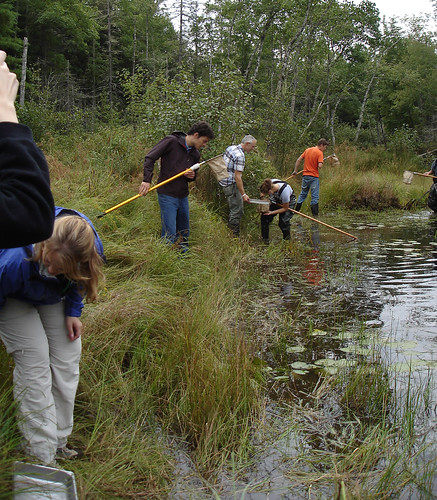(Data collection for the Acadia Learning Project. Image courtesy of the Maine Sea Grant.)
A group of collaborators from Maine have answered this question with a resounding "no." The collaborators are responsible for the Acadia Learning Project (ALP), a 5-year-old "scientist-teacher-student partnership" (STSP) involving 11 schools, more than 20 teachers, and thousands of students. The primary purpose of the project is to educate students about the scientific process while generating a useful ecological dataset for researchers at the University of Maine. However, ALP has also been useful for testing whether it is possible for scientists and students to benefit equally from this sort of partnership.
There are many reasons why people have doubted the likelihood of a mutually beneficial "STSP in an FSE setting." For one thing, students are only beginning to learn about science and may therefore need quite a lot of information to get up to speed on organisms, ecosystems, data collection techniques, and statistical analyses; they are also likely to make mistakes as they learn about how to perform certain methodologies. While teachers can help address some of these problems, most will not have received the sort of scientific training necessary to answer all of the questions that may arise. It would be useful to have professional scientists on hand to provide tutorials, but most researchers will be teaching their own classes and taking care of other academic obligations. All in all, it doesn't seem like an easy task to balance out everyone's needs and ensure that all participants benefit in the end.
Knowing of the potential pitfalls of their collaboration, ALP participants utilized a series of evaluations in order to see what aspects of the project might need tweaking. Early on, they found that students could collect data (in this case, on spatial variations of mercury load in wildlife) but were not able to interpret what the information meant. For instance, students were asked to create graphs allowing them to visualize their own results and compare them to the findings of other research groups. This proved to be a difficult task, suggesting that something needed to be done to improve the education aspects of the STSP. The scientists also conducted interviews with teachers, who indicated that they would appreciate having greater access to researchers and a better understanding of how the data would be used; the educators hoped that both of these goals would help them improve student motivation. Cumulatively, these needs and desires showed that the teachers and students "needed additional support to undertake basic scientific work"--but also proved that they "valued the engagement with a real and complex project."
One of the first things that the scientists wanted to address was the potential tension arising from the fact that teachers had originally expected the students to examine the very same questions of interest to the researchers, and were surprised when this did not happen. As the scientists pointed out, "the students had neither the training nor the knowledge to consider such questions;" further, if students were to focus on these questions (e.g., how Hg biomagnifies and whether it can be used as a proxy for methylmercury), they would not get as much information about the more general topics on which they would later be tested in school (e.g., food webs and energy requirements of animals in different trophic levels).
(Field work during the Acadia Learning Project. Image courtesy of the ALP.)
To better integrate academic and educational goals, the researchers developed a plan involving "regular online and occasional in-person access to scientists"--a technique designed to help students identify research questions that were interesting and useful to both parties. The researchers also organized summer institutes for teachers, providing the educators with the information they needed to help students with project design and data analysis. A review of student performance before and after the "tweaking" revealed improvements in students' ability to create useful graphs and compare their data with those collected by other groups.
Teachers reported that students were highly motivated to "carefully follow field protocols to ensure that samples were useful;" in other words, in addition to collecting data for their own projects, the students wanted to ensure that their datasets could also be used by the researchers. According to the researchers, one teacher has gone "beyond normal classroom science" by using the research protocols in a nearby wildlife refuge and creating a "body of student work that has value in its own right." Likewise, one student took the science course twice in order to have the chance to continue his research. At the same time, the academic researchers were able to use the data generated by the ALP to write publishable journal papers and successfully apply for grants.
Cumulatively, these successes indicate that it is possible for multiple groups of people to approach an STSP "with different needs and inputs, collaborate during program design and implementation, and then diverge, focusing on different outputs and seeking different outcomes." The key seems to be periodically re-evaluating the program to see what needs to be altered, as well as having a willingness to put in some extra-curricular effort to make sure that everyone is on the same page with how the project should proceed. Additionally, the researchers promote program designs that "place equal emphasis on scientific outcomes and learning outcomes"--in other words, teachers and scientists have to be willing to meet each other halfway. If they succeed, the resulting projects can be useful not only to teachers and researchers of all ages, but also--depending on the nature of the research--to conservationists, managers, and the organisms being studied.
---
Zoellick B, Nelson SJ, and Schauffler M. 2012. Participatory science and education: bringing both views into focus. Frontiers in Ecology and the Environment 10(6):310-313.

No comments:
Post a Comment